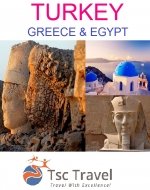PLANNING TO GO TURKEY?
Find the best Tour in Turkey...
TURKEY TRAVEL GUIDE
EDIRNE
Edirne was capital of the Ottoman empire before Mehmet II conquered Constantinople and moved his court there, Edirne is blessed with imperial building stock, a notable culinary heritage and a lingering and much-cherished sense of civic grandeur. Close to the Greek and Bulgarian borders, the city has a European flavour that is best appreciated in summer, when locals party on the banks of the Tunca and Meriç Rivers and cheer on the contestants at the world-famous Kırkpınar oil-wrestling festival.
Things to do
Süleymaniye Mosque
Built between 1569 and 1575 by order of Sultan Selim II at the city's highest point, the mosque features four striking 71m-high minarets and was positioned in the centre of an extensive külliye (mosque complex) including a medrese (Islamic school of higher studies), darül Hadis (Hadith school) and arasta (arcade of shops). The main entrance is through the western courtyard, home to a lovely marble şadırvan (ablution fountain).
Inside, the broad, lofty dome – at 31.3m, marginally wider than that of İstanbul's Aya Sofya – is supported by eight unobtrusive pillars, arches and external buttresses, creating a surprisingly spacious interior. As they only bear a portion of the dome's weight, the walls are sound enough to hold dozens of windows, the light from which brings out the interior's colourful calligraphic decorations.
Unesco added the mosque and its külliye to its World Heritage list in 2011.
Sultan Beyazıt II Mosque Complex
Standing in splendid isolation on the banks of the Tunca River, this complex was commissioned by Sultan Beyazıt II and built between 1484 and 1488. The mosque's design lies midway between the Üç Şerefeli and Selimiye models: its prayer hall has one large dome, similar to the Selimiye, but it also has a courtyard and fountain like the Üç Şerefeli. The külliye (mosque complex) includes a tabhane (travellers hostel), tımarhane (asylum), tip medresesi (medical school) and darüşşifa (hospital).



